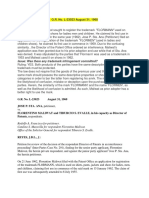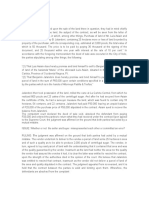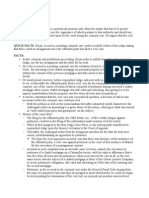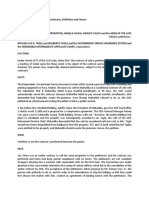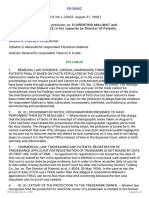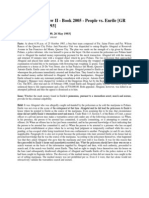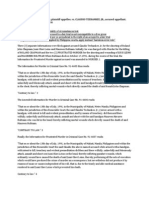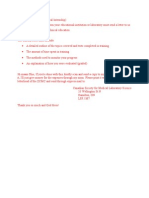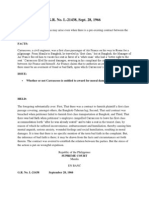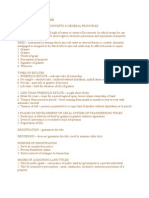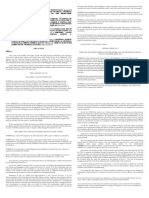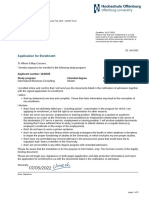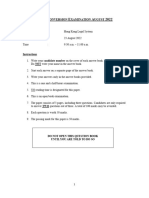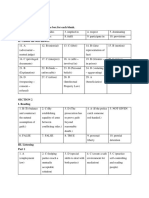Ipl Cases
Ipl Cases
Uploaded by
Ad Altiora TendoCopyright:
Available Formats
Ipl Cases
Ipl Cases
Uploaded by
Ad Altiora TendoOriginal Description:
Original Title
Copyright
Available Formats
Share this document
Did you find this document useful?
Is this content inappropriate?
Copyright:
Available Formats
Ipl Cases
Ipl Cases
Uploaded by
Ad Altiora TendoCopyright:
Available Formats
JOSE P. STA. ANA, petitioner, vs. FLORENTINO MALIWAT and TIBURCIO S. EVALLE, in his capacity as Director of Patents, respondents.
G.R. No. L-23023 | 1968-08-31
DECISION
REYES, J.B.L., J.: Petition for review of the decision of the respondent Director of Patents in an interference proceeding 1 (Inter Partes Case No. 291) finding for the senior party applicant, Florentino Maliwat, the herein private respondent, and against the junior party applicant 2 , Jose P. Sta. Ana, the herein petitioner. On 21 June 1962, Florentino Maliwat filed with the Patent Office an application for registration of the trademark FLORMANN, which is used on shirts, pants, jackets and shoes for ladies, men, and children, claiming first use in commerce of the said mark on 15 January 1962. The claim of first use was subsequently amended to 6 July 1955. On 18 September 1962, Jose P. Sta. Ana filed an application for the registration of the trade-name FLORMEN SHOE MANUFACTURERS (SHOE MANUFACTURERS disclaimed) 3 , which is used in the business of manufacturing ladies' and children's shoes. His claim of first use in commerce of the said tradename is 8 April 1959. In view of the admittedly confusing similarity between the trade mark FLORMANN and the tradename FLORMEN, the Director of Patents decreed an interference. After trial, the respondent Director gave due course to Maliwat's application and denied that of Sta. Ana. The latter, not satisfied with the decision, appealed to this Court. The petitioner assigned the following errors: "I. The Director of Patents erred in not finding that respondent (senior party-applicant) failed to establish by clear and convincing evidence earlier date of use of his mark FLORMANN than that alleged in his application for registration, hence, respondent is not entitled to carry back the date of first use to a prior date. "II. The Director erred in holding that respondent is the prior adopter and user of his mark and in concluding that this is strengthened with documentary evidence that respondent has been using his mark since 1953 as tailor and haberdasher. "III. The Director of Patents erred in not finding false and fabricated respondent's testimonial and documentary evidence and Director should have applied the rule 'Falsus in uno, falsus in omnibus' and should have disregarded them. "IV. The Director of Patents erred in declaring that Maliwat has the prior right to the use of his trademark on shoes and such right may be carried back to the year 1953 when respondent started his tailoring and haberdashery business, and in holding that the manufacture of shoes is within the scope of natural expansion of the business of a tailor and haberdasher. "V. The Director of Patents erred in failing to apply the stricture that parties should confine use of their respective marks to their corresponding fields of business, and should have allowed the concurrent use of trade-name FLORMEN SHOE MANUFACTURERS and the trademark FLORMANN provided it is not used on shoes." The findings of the Director that Maliwat was the prior adopter and user of the mark cannot be contradicted, since his findings were based on facts stipulated in the course of the trial in the interference proceedings. The recorded stipulation is as follows: "ATTY. FRANCISCO: Your honor please, with the mutual understanding of the counsel for the Junior Party and the counsel for the Senior Party in their desire to shorten the proceedings of this case, especially on matters that are admitted and not controverted by both parties, they have agreed and admitted that Mr.
Jose P. Sta. Ana, the Junior Party Applicant in this case, is engaged solely in the manufacture of shoes under the firm name FLORMEN SHOE MANUFACTURERS since April 1959; that the name FLORMEN SHOE MANUFACTURERS is registered with the Bureau of Commerce on April 8, 1959, as shown by Exhibits 'A' and 'A-2'. That Mr. Florentino Maliwat has been engaged in the manufacture and sale of men's wear, shirts, polo shirts, and pants, since 1953, using FLORMANN as its trademark. That Mr. Florentino Maliwat began using the trademark FLORMANN on shoes on January 1962 and the firm name FLORMANN SHOES under which these shoes with the trademark FLORMANN were manufactured and sold was first used on January 1962, having also been registered with the Bureau of Commerce on January 1962 and with other departments of the government, like the Bureau of Labor, the Social Security System and the Workmen's Compensation in 1962. ATTY. MARAVILLA: On behalf of the Senior Party Applicant, represented by this humble representation, I respectfully concur and admit all those stipulations above-mentioned. HEARING OFFICER: The court reserves the resolution on those stipulations. We can proceed now with the redirect examination." (T.s.n., 9 August 1963, pp. 33-34). And the Rules of Court provide: "SEC. 2. Judicial Admissions. - Admissions made by the parties in the pleadings, or in the course of the trial or other proceedings do not require proof and can not be contradicted unless previously shown to have been made through palbable mistake." (Rule 129, Revised Rules of Court) Since the aforequoted stipulation of facts has not been shown to have been made through palpable mistake, it is vain for the petitioner to allege that the evidence for respondent Maliwat is false, fabricated, inconsistent, indefinite, contradictory, unclear, unconvincing, and unsubstantial. The rule on judicial admissions was not found or provided for in the old Rules but can be culled from rulings laid down by this Court previous to its revision (Irlanda v. Pitargue, 22 Phil. 383; 5 Moran 57-59, 1963 Ed.). It was the law, then and now, being an application of the law on estoppel. To be true, petitioner Sta. Ana, through counsel, filed with this Court, on 24 December 1964, a motion entitled "MOTION TO ORDER STENOGRAPHER TO PRODUCE STENOGRAPHIC NOTES AND TO CORRECT TRANSCRIPT OF STENOGRAPHIC NOTES; TO ALLOW PETITIONER TO WITHDRAW FROM STIPULATION OF FACTS AND BE ALLOWED TO PRESENT ADDITIONAL EVIDENCE; AND TO SUSPEND PERIOD FOR FILING PETITIONER'S BRIEF." The reason given was that "counsel for Mr. Jose P. Sta. Ana does not recall making any stipulation or agreement of facts with the counsel of Mr. Florentino Maliwat on 9 August 1963". Opposition thereto was filed by Maliwat, asserting that the stenographer took down notes on those things which were stated and uttered by the parties; the movant should have moved for reconsideration in the Patent Office, instead of here in the Supreme Court, which is both untimely and unhonorable. Upon requirement by this Court, stenographer Cleofe Rosales commented on petitioner's motion that what she had taken down were actually uttered by counsel for Sta. Ana, no more, no less; that it was practically and highly impossible for her to have intercalated into the records the questioned stipulation of facts because of the length of counsel's manifestations and the different subject matters of his statements, aside from the concurrence of Maliwat's counsel and the reservation on the resolution made by the hearing officer; and that despite her length of service, since 1958, as stenographic reporter, there had been no complaint against her, except this one. Counsel for Sta. Ana replied to the foregoing comments, alleging, among others, that after his receipt of the decision, after 5 May 1964, he bought the transcript and requested the stenographer to verify the contents of pages 33 and 34 of her transcript but, despite several requests, and for a period of seven (7) months, for her to produce the stenographic notes, she has failed to produce said notes. On 2 April 1965, stenographer Rosales sent to the clerk of this Court the transcript of stenographic notes. This Court, on 2 February 1965, denied, for being late, the motion to present additional testimonial and documentary evidence, and, on 8 April 1965, deferred action on the objection to a portion of the transcript until after hearing.
We find no substantiation of the charge that the stipulation of facts appearing on pages 33 to 34 of the transcript of stenographic notes taken on 9 August 1963 had been intercalated; hence, the presumption that the stenographer regularly performed her duty stands. The integrity of the record being intact, the petitioner is bound by it. We can not overlook that even if his charges were true, it was plain and inexcusable negligence on his part not to discover earlier the defect he now complains of, if any, and in not taking steps to correct it before the records were elevated to this Court. An applicant for registration is not bound by the date of first use as stated by him in his application, but is entitled to carry back said stated date of first use to a prior date by proper evidence; but in order to show an earlier date of use, he is then under a heavy burden, and his proof must be clear and convincing (Anchor Trading Co., Inc. vs. The Director of Patents, et. al., L-8004, 30 May 1956; Chung Te vs. Ng Kian Ciab, et al., L-23791, 23 November 1966). In the case at bar, the proof of date of first use (1953), earlier than that alleged in respondent Maliwat's application (1962), can be no less than clear and convincing because the fact was stipulated and no proof was needed. Petitioner would confine the respondent to the use of the mark FLORMANN to tailoring and haberdashery only, but not on shoes, on the ground that petitioner had used the name FLORMEN on shoes since 1959, while the respondent used his mark on shoes only in 1962; but the Director ruled: ". . . I believe that it is now the common practice among the local tailors and haberdashers to branch out into articles of manufacture which have, one way or another, some direct relationship with or appurtenance to garments or attire to complete one's wardrobe such as belts, shoes, handkerchiefs, and the like . . . It goes without saying that shoes on one hand and shirts, pants and jackets on the other, have the same descriptive properties for purposes of our Trademark Law." Modern law recognizes that the protection to which the owner of a trademark is entitled is not limited to guarding his goods or business from actual market competition with identical or similar products of the parties, but extends to all cases in which the use by a junior appropriator of a trade mark or trade-name is likely to lead to a confusion of source, as where prospective purchasers would be misled into thinking that the complaining party has extended his business into the field (see 148 ALR 56 et seq; 52 Am Jur. 576) or is in any way connected with the activities of the infringer; or when it forestalls the normal potential expansion of his business (v. 148 ALR., 77, 84; 52 Am. Jur. 576, 577). It is on this basis that the respondent Director of Patents adverted to the practice "among local tailors and haberdashers to branch out into articles of manufacture which have some direct relationship" . . ., "to garments or attire to complete one's wardrobe". Mere dissimilarity of goods should not preclude relief where the junior user's goods are not too different or remote from any that the owner would be likely to make or sell: and in the present case, wearing apparel is not so far removed from shoes as to preclude relief, any more than the pancake flour is from syrup or sugar cream (Aunt Jemima Mills Co. vs. Rigney & Co. LRA 1918C 1039), or baking powder from baking soda (Layton Pure Food Co. vs. Church & Co., 182 Fed. 35), or cosmetics and toilet goods from ladies' wearing apparel and costume jewelry (Lady Esther Ltd. vs. Lady Esther Corset Shoppe, 148 ALR 6). More specifically, manufacturers of men's clothing were declared entitled to protection against the use of their trademark in the sale of hats and caps [Rosenberg Bros. vs. Elliot, 7 Fed. (2d) 962] and of ladies shoes (Forsythe & Co. vs. Forsythe Shoe Corp., 254 NYS 584). In all these cases, the courts declared the owner of a trade mark from the first named goods entitled to exclude use of its trademark on the related class of goods above-referred to. It may be that previously the respondent drew a closer distinction among kinds of goods to which the use of similar marks could be applied; but it can not be said that the present ruling under appeal is so devoid of basis in law as to amount to grave abuse of discretion warranting reversal. Republic Act No. 166, as amended, provides: "SEC. 4 . . . The owner of a trade-mark, trade-name or service- mark used to distinguish his goods, business or services from the goods, business or services of others shall have the right to register the same on the principal register, unless it: "xxx xxx xxx "(d) Consists of or comprises a mark or trade-name which resembles a mark or trade-name registered in the Philippines or a mark or trade-name previously used in the Philippines by another and not abandoned,
as to be likely, when applied to or used in connection with the goods, business or services of the applicant, to cause confusion or mistake or to deceive purchasers; "xxx xxx xxx Note that the provision does not require that the articles of manufacture of the previous user and the late user of the mark should possess the same descriptive properties or should fall into the same categories as to bar the latter from registering his mark in the principal register (Chua Che vs. Phil. Patent Office, et al., L-18337, 30 Jan. 1965 4 , citing Application of Sylvan Sweets Co., 205 F. 2nd, 207). 5 Therefore, whether or not shirts and shoes have the same descriptive properties, or whether or not it is the prevailing practice or the tendency of tailors and haberdashers to expand their business into shoemaking, are not controlling. The meat of the matter is the likelihood of confusion, mistake or deception upon purchasers of the goods of the junior user of the mark and the goods manufactured by the previous user. Here, the resemblance or similarity of the mark FLORMANN and the name FLORMEN and the likelihood of confusion, one to the other, is admitted; therefore, the prior adopter, respondent Maliwat, has the better right to the use of the mark. FOR THE FOREGOING REASONS, the appealed decision is hereby affirmed, with costs against the petitioner. Concepcion, C. J., Dizon, Makalintal, Zaldivar, Sanchez, Castro, Angeles and Fernando, JJ., concur. Footnotes 1. "An interference is a proceeding instituted for the purpose of determining the question of priority of adoption and use of a trade- mark, trade-name, or service-mark between two or more parties claiming ownership of the same or substantially similar trade-mark, trade-name or service-mark." (Sec. 10-A, Republic Act No. 166 as amended) 2. "The party whose application or registration involved in the interference has the latest filing date is the junior party . . ." (Rule 184, Rev. Rules of Practice in the Philippines Patent Office) "Any junior party in an interference proceeding, . . , shall be deemed to be in the position of plaintiff, and the other parties to such proceedings, to the position of defendants, with respect thereto . . ." (Rule 167, Ibid) 3. "At any time, upon application of the registrant and payment of the required fee, the Director may permit any registration to be surrendered, cancelled, or for good cause shown to be amended, and he may permit any registered mark or tradename to be disclaimed in whole or in part: . . ." (Sec. 14, Republic Act No. 166, as amended) 4. between toiletries and laundry soap. 5. between candies and cigarettes.
BRISTOL MYERS COMPANY, petitioner, vs. THE DIRECTOR OF PATENTS and UNITED AMERICAN PHARMACEUTICALS, INC., respondents. G.R. No. L-21587 | 1966-05-19
DECISION
BENGZON, J.P., J.: A petition for registration in the Principal Register of the Patent Office of the trademark "BIOFERIN" was filed on October 21, 1957 by United American Pharmaceuticals, Inc. Said domestic corporation first used the afore-stated trademark in the Philippines on August 13, 1957. It covers "a medicinal preparation of antihistamic, analgesic, antipyritic with vitamin C and Bioflavenoid used in the treatment of common colds, influenza and other febrile diseases with capillary hemmorrhagic tendencies." The product falls under Class 6 of the official classification, that is, "Medicines and Pharmaceutical Preparations". Bristol Myers Co., a corporation of the State of Delaware, U.S.A., filed on January 6, 1959 an opposition to the application. Said oppositor is the owner in the Philippines of the trademark "BUFFERIN" under Certificate of Registration No. 4578 issued by the Philippine Patent Office on March 3, 1954. Its trademark is also registered in the United States under Certificate of Registration No. 566190 issued on November 4, 1952. It was first used in the Philippines on May 13, 1953. The product covered by "BUFFERIN" also belongs to Class 6, Medicines and Pharmaceutical Preparations. Designated as "Antacid analgesic", it is intended for relief in cases of "simple headaches, neuralgia, colds, menstrual pain and minor muscular aches." The thrust of oppositor's contention was that the registration of the applicant's trademark "BIOFERIN" would violate its rights and interest in its registered trademark "BUFFERIN" as well as mislead and confuse the public as to the source and origin of the goods covered by the respective marks, in view of the allegedly practically the same spelling, pronunciation and letter type design of the two trademarks covering goods of the same class. The parties thereafter filed on January 18, 1961 a joint petition stipulating as to the facts and submitting the case upon the issue of whether or not, considering all the factors involved, in both trademarks - as the parties would discuss in their memoranda - there will be such confusing similarity between the two trademarks as will be likely to deceive the purchasing public. After submission of memoranda, on June 21, 1963 the Director of Patents rendered a decision granting the petition and dismissing the opposition, on the ground that, all factors considered, the trademarks in question are not confusingly similar, so that the damage feared by the oppositor will not result. From said decision the oppositor appealed to this Court by petition for review filed on July 24, 1963. The sole issue raised thereby is: Are the trademarks "BIOFERIN" and "BUFFERIN", as presented to the public in their respective labels, confusingly similar? Appellant contends that confusing similarity will obtain because both products are primarily used for the relief of pains such as headaches and colds; and because the words "BIOFERIN and "BUFFERIN" are practically the same in spelling and pronunciation. In determining whether two trademarks are confusingly similar, the test is not simply to take their words and compare the spelling and pronunciation of said words. Rather, it is consider the two marks in their entirety, as they appear in the respective labels, in relation to the goods to which they are attached. Said rule was enunciated by this Court through Justice Felix Bautista Angelo in Mead Johnson & Co., vs. N.V.J. Van Dorp, Ltd., L-17501, April 27, 1963, thus: "It is true that between petitioner's trademark 'ALACTA' and respondent's 'ALASKA' there are similarities in spelling, appears and sound for both are composed of six letters of three syllables each and each syllable has the same vowel, but in determining if they are confusingly similar a comparison of said
words is not the only determining factor. The two marks in their marks in their entirety as they appear in the respective labels must also be considered in relation to the goods to which they are attached. The discerning eye of the observer must focus not only on the predominant words but also on the other features appearing in both labels in order that he may draw his conclusion whether one is confusingly similar to the other. . . ." Applying this test to the trademarks involved in this case, it is at once evident that the Director of Patents did not err in finding no confusing similarity. For though the words "BIOFERING" and "BUFFERIN" and "Bufferin" have the same suffix and similar-sounding prefixes, they appear in their respective labels with strikingly different backgrounds and surroundings, as to color, size and design. For convenience we sum up these differences, as follows: Relevant Factors "BIOFERIN" "BUFFERIN" 1. Shape & Size of Rectangular about Rectangular, Label 3-3/4" 2-1/4" 3-3/4" 1-1/4" 2. Color of Label Predominantly Predominantly Yellow White 3. Color background Olive-green Blue of word-mark 4. Over-all Layout At the top center At left side of label word-mark "BIOFE- "BUFFERIN"; with RIN"; below it are "Bristol Myers Co., contents of medicine, New York, N.Y." arranged horizontally; below it; at right side, at bottom, center, contents, indications, "United Pharma dosage are grouped ceuticals, Inc." together, printed in olive-green perpendicularly. background. At left side - dosage, printed perpendicularly; at rigth side, indications, also perpendicularly printed. 5. Forms of Product Capsules - Tablets label says: label says: "50 capsules" "36 Tablets" 6. Prescription Label states: No such "To be dispensed statement only by or on the prescription of a physicians" Accordingly, taken as they will appear to a prospective customer, the trademarks in question are not apt to confuse. Furthermore, the product of the applicant is expressly stated as dispensable only upon doctor's prescription, while that of oppositor does not require the same. The chances of being confused into purchasing one for the other are therefore all the more rendered negligible. Although oppositor avers that some drugstores sell "BIOFERIN: without asking for a doctor's prescription, the same if true would be an irregularity not attributable to the applicant, who has already clearly stated the requirement of a doctor's prescription upon the face of the label of its product. Wherefore, the decision of the Director of Patents appealed from is hereby affirmed without costs. So ordered. Bengzon, C.J., Bautista Angelo, Concepcion, J.B.L. Reyes, Barrera, Dizon, Regala, Makalintal, Zaldivar and Sanchez, JJ., concur.
AMERICAN CYANAMID COMPANY, petitioner, vs. THE DIRECTOR OF PATENTS and TIU CHIAN, respondents. G.R. No. L-23954 | 1977-04-29
MU'OZ PALMA, J.: This is an appeal from a decision of the Director of Patents in Inter Partes Case No. 140 entitled "American Cyanamid Company, petitioner, versus Tiu Chian, respondent which denied the petition of American Cyanamid Company to cancel the registration of the trademark SULMETINE issued in favor of Tiu Chian. The factual background of this case follows: Petitioner to which We shall refer at times as Cyanamid field on April 3, 1959, a petition to cancel certificate of registration No. 5348 issued on July 6, 1956, in favor of respondent Tiu Chian of the Latter's trademark SULMETINE used on medicine for the control of infectious coryza and for the prevention of cold rhinitis, roup, cecal coccidiosis and intestinal coccidiosis of chicken and other domesticated birds. Cyanamid claims that it is the owner of a trademark SULMET which it had used for many years in the United States since 1946 and which was duly Registration No. 431929 and which was first used in the Philippines on May 25, 1950, for which it filed an application for registration of the same in this country on May 3, 1956. SULMET is the trademark of a veterinary product used, among other purposes, "for the control of outbreaks of ceal and intestinal coccidiosis in turkeys' and for reducing mortality in pullorum disease in baby chicks, acute fowl cholera in chickens, turkeys and ducks and anatipistifer disease in ducks." Through long use in the country, SULMET has become popular and well-known and enjoys widespread reputation brought about by extensive advertisement and promotion through the media. Notwithstanding the above, respondent filed an application for registration of SULMETINE as his trademark on a veterinary product used for the same purposes thereby making respondent's product confusingly with that of petitioner which is unfair and unjust to the label. In support of its Petition for cancellation, Cyanamid presented as its Exhibit B a sample of the label used on its product and as Exhibit C a sample of the label of respondent Tiu Chian used on the latter's product. (pp. 264-265, original record) It likewise submitted among its exhibits several indent orders issued by F.E. ZUELLIG, INC. to various business companies,; covering petitioner's Sulmet Solution (Exhibits H, H-1, J, J-1, I, I-1, K, and L). Respondent Tiu Chian opposed this Petition for cancellation of his trademark SULMETINE. On June 9, 1964, the Director of Patents rendered his decision denying the Petition for cancellation of respondent's certificate of registration of the trademark SULMETINE, based on the following findings: (1) Petitioner's trademark SULMET (Exhibit B) is used on a preparation for practically all domesticated animals such as fowl, cattle, pigs, horses and sheep, whereas, SULMENTINE is limited only to chicken and other domisticated birds. This distinction is evident from the printed matter appearing on the respective labels of the parties. Thus, on respondent's label (Exhibit C) it is indicated thereon that the preparation is for treatment of birds and chicken (p. 265 volume of exhibits), whereas, the label (Exhibit B) of petitioner indicates that the product is for chicken, turkey, duck, and may be employed in the treatment of certain conditions in horses, cattle, calves, sheep, and swine (p. 264, Idem). (2) On top of petitioner's label, Exhibit B, the word "CYANAMID" is printed in prominent letters and at
the bottom of the label there appears in bold letters the words "AMERICAN CYANAMID COMPANY, NEW YORK 20, N.Y." indicating the manufacturer of the product. On the other hand, at the top of respondent's label, Exhibit C, there appears the pictures of two roosters with the word "HENRY'S" inbetween, and at the bottom "HENRY'S LABORATORIES PHILIPPINES" are clearly printed indicating the source of the product. (3) Petitioner's preparation consists of a dringking water solution and this is clearly indicated in bold letters on the label, whereas, the of respondent consists of tablets for veterinary use prominently indicated in red letters on the label, Exhibit C. The above differences in the physical aspect or appearance of the respective labels were found by the Director of Patents substantial and striking enough so as to prevent any confusing similarity between the two which may lead a buyer to confuse one with the other. With respect to Petitioner's contention that respondent's trademark bears the two syllables of petitioner's SULMET and that respondent merely added the syllable "INE", the Director of Patents reasoned out that the syllables "SUL" and "MET" are coined from a common source suggestive of chemical compounds which are attributes of the products of the parties herein, that is, "SUL" being derived from "SULFA" and "MET" from methyl, so that neither party may claim exclusive use to them, and that with the addition of the syllable "INE" by respondent, a marked distinction is affected to distinguished the two trademarks. The Director of Patents likewise found that no material damage was sustained by petitioner during the time that respondent was using SULMETINE on its products. Thus, it is shown from Exhibit S that the total of the sales of SULMET product was P72,824.35 in 1959, which increased to P123,641.85 in 1960, and that although in 1961 the sales decreased slightly to P118,621.25, that was offset considerably by the sudden increase to P161,238.65 in 1962. From the foregoing decision, American Cyanamid Company appeals to this Court and submits five assigned errors, to wit: First Assignment of Error Respondent Director of Patents erred in finding that petitioner did not have priority in the use of its trademark SULMET over respondent Tiu Chian's use of his trademark SULMETINE. Second Assignment of Error Respondent Director of Patents erred in holding that the trademark SULMETINE is not confusingly similar to the trademark SULMET. Third Assignment of Error Respondent Director of Patents erred in holding that respondent Tiu Chian's certificate of registration No. 5348 for the trademark SULMETINE was not obtained by fraud. Fourth Assignment of Error Respondent Director of Patents erred in holding that petitioner is legally obliged to prove damages by reason of the issuance of certificate of registration No. 5348 as a condition precedent for obtaining its cancellation.
Fifth Assignment of Error Respondent Director of Patents erred in delegating the authority to hear and receive the evidence in this case to a so-called hearing officer and therefor he has no jurisdiction to render the decision appealed from because he did not hear the case nor receive the evidence thereof. We view the second assignment of error as the issue which goes to the very heart of the litigation, the disposition of which renders the treatment of the, other assigned errors unnecessary. The problem therefore to be resolved is whether or not petitioner correctly claims that respondent's trademark SULMETINE was copied from its trademark SULMETINE giving rise to a confusing similarity between the two in violation of Republic Act 166 otherwise known as the Trade-Mark Law. We find petitioner's submittal devoid of merit and hold that there is no infringement of trademark which justify a cancellation of respondent's registered trademark SULMETINE. 1. An examination of the documentary evidence submitted by the parties confirms the findings of the Director of Patents that there are striking differences between the two labels, Exhibits B and C, which preclude the possibility of the purchasing public confusing one product with the other. Said labels are entirely different in size, background, colors, contents, and pictorial arrangement: in short. the general appearances of the labels bearing the respective trademarks are so distinct from each other that petitioner cannot assert that the dominant features, if any, of its trademark were used or appropriated in respondent's own. Thus (a) The coloring scheme: Petitioner's SULMETINE label, Exhibit B, has a white background with the word SULMETINE printed in dark green, while respondent's SULMETINE label, Exhibit C, is dark yellow in color, and the word SULMETINE. is printed in dark blue. In fact, Exhibit B carries mainly two colors - white and green, while Exhibit C uses yellow, blue, and red (b) The pictorial representation: Respondent's label, Exhibit C, presents at its top the pictures of two roosters and in between is the word "HENRY'S" printed in an egg-shaped enclosure, while petitioner's label carries no such pictorial representation nor even one similar to it, for what appears on the top of its label is the word "CYANAMID" printed in bold and widely-spaced green letters. (c) The printed matter on the label: A very important point of difference between the labels of the parties is found in the cotents of the printed matter. In the label Exhibit B, the product is described in bold green letters as "Drinking Water Solution" and the printed directions indicate that it is for use of chicken flocks, turkeys, ducks, as well as in certain conditions for horses, cattle, calvess, sheep, and swine. On the other hand, in respondent's label Exhibit C what are printed in bold red letters are "Tablets Veterinary". Except for the use of the words "Adult birds" and "Small chicks", there is nothing in Exhibit C which indicates that the preparation may be used for turkesy, ducks, or for any other domesticated animals mentioned in the SULMET label. On this point, it is significant to note that the product represented by the trademarks of the parties is a medicianal preparation for veterinary use, consequently, a prospective buyer will be cautious and prudent enough to examine the contents of the printed matter on the label, unlike in a situation where the product is for ordinary personal or household use, such as soap and other tiolet articles, biscuits, candies, and ther like where the consumer is not expected to exercise moer than ordinary diligence in the choice or selectioon a purchase not to ascertain that what he is purchasing is a animals, and in the process mistake a water solution for a tablet over vice versa.
(d) The clear indication of the source: Petitioner's label clearly indicates that the product SULMET is of foreign origin. Not only is the word "CYANAMID" printed in big widely-spaced letters at the top of the label but at the bottom thereof the words "AMERICAN CYANAMID COMPANY, NEW YORK 20, N.Y." are printed in white capital letters against a dark green background. In respondent's SULMENTINE label, Exhibit C, the name "HENRY'S" in turn is printed clearly above the word SULMETINE and at the bottom of the label the phrase "HENRY'S LABORATORIES PHILIPPINES"" is printed in white letters against a dark blue background making it distinctly visible. Thus, looking at the two labels Exhibits B and C it is quite apparent that the source of the product is predominantly indicated thereby discounting petitioner's assertion that the SULMETINE trademark is a plain copy of its own with intent to pass respondent's article as coming from the same source as that of petitioner's medicinal preparation. What have been stated above sufficiently throws out petitioner's second assignment of error. 2. In page 56 of petitioner's brief the case of Lim Hoa vs. Director of Patents, L-8072, October 31, 1956, is invoked in support of this appeal. However, that case is not controlling because the article in question in Lim Hoa was a food seasoning product which according to this Court is "generally purchased by cooks and household help, sometimes illiterate, who are guided by pictorial representations"; that the two roosters appearing in the trademark of applicant and the hen appearing in the trademark of the oppositor although of different sexes belong to the same family of chicken known as "manok" so that when a cook or a housewife buys a food seasoning product for the kitchen the brand of "manok" or "marka manok" will be uppermost in her mind and regardless of whether the picture is a hen or a rooster, to her, they are all "manok", and consequently there lies the confusion, even deception. In this case of SULMET and SULMETINE, the product is for medicinal veterinary use and consequently, the purchaser will be more wary of the nature of the product he is buying. Contrary to the allegation of petitioner herein, the source or manufacturer of the article will be a most important factor in the mind of the purchaser in selecting the article he will buy, and a preparation manufactured by a well-known foreign company such as the "American Cyanamid Company, New York", enjoys a decided advantage over one which is locally produced and manufactured by an unknown entity such as "Henry's Laboratories". What is relevant to and decisive of the case at bar is Mead Johnson & Co. vs. N.V.J. Van Dorp. Ltd., et al., L-17501, decided on April 27, 1963, barely a year before the appealed decision in the instant case. Van Dorp, Ltd., a Netherlands corporation, filed an application for the registration of its trademark "ALASKA and pictorial presentation of a Boy's Head with a rectangular design." Mead Johnson, a corporation organized under the laws of Indiana, U.S.A., being the owner of a trademark "ALACTA" used for powdered half-skim milk, which was registered with the Patent Office on June 12, 1951, opposed the registration on the ground that it will be damaged by the use of the trademark "ALASKA" on milk products, etc., the same being confusedly similar to its trademark "ALACTA". The Director of Patents dismissed the opposition and approved for registration the trademark "ALASKA" on the ground that the applicant's trademark does not sufficiently resemble oppositor's mark as to cause confusion or mistake or deceive purchasers. This Court through Justice Bautista Angelo upheld the findings of the Director of Patents. The Court held that while there are similarities in spelling, appearance and sound between "ALACTA" and "ALASKA" the trademarks in their entirety as they appear in their respective labels show glaring and striking differences or dissimilarities such as in size of the containers, the colors of the labels, inasmuch as one uses light blue, pink, and white, while Van Dorp contains uses two colors "ALACTA" has only the first letter capitalized and is written in black while the mark "ALASKA" has all the letters capitalized written in while except that of the condensed full cream milk which is in red. 1
Ethepa vs. the Director of Patents, Westmont Pharamaceutical, Inc. is another case in point. In Ethepa, the question was whether the trademark "ATUSSIN" of Westmont may be registered in the Philippines notwithstanding the objection of Ethepa which claimed that it would be damaged because "ATUSSIN" is so confusingly similar with "PERTUSSIN" registered in this country on September 25, 1957. The Director of Patents approved the application for the registration of the trademark "ATUSIN" and his decision was appealed to this Court. In disposing of the appeal, the Court affirmed the decision of the Director of Patents holding, inter alia, that a practical approach to the problem of similarity or dissimilarity is to go into the whole of the two trademarks pictured in their manner of display; that taking a casual look at the two labels it is shown that they are entirely different in color, contents, arrangement of words thereon, sizes, shape, and general appearance so that the label of one cannot be mistaken for that the other; that the use of the word "tussin" as an component of both trademarks cannot be considered as a factor for declaring the two confusingly similar for "tussin" is descriptive and generic and is open for apropriation by anyone, and that while the word by itself cannot be used exclusively to Identify one goods it may properly become a subject of a a trademark by combination with another word or phrase; hence, Ethepa's "Pertussin " and Westmonth's Atussin" 2 Similarly, in the case before Us, as correctly stated by the Director of Patents, the word SULMET is derived from a combination of the syllables "SUL" which is derived from Sulfa and "MET" from methyl both of which are chemical compounds present in the article manufactured by the contending parties, and the addition of the syllable "INE" in respondent's label is sufficient to distinguish respondent's product or trademark from that of petitioner. 3. Petitioner also asserts that the trademarks of the parties are used on Identical goods and for Identical purposes and that this is an important factor in determining whether or not there is infringement of a trademark. (p. 49, petitioner's brief). We cannot agree with petitioner that the trademarks are used on Identical goods because as already indicated earlier, petitioner's SULMET label, Exhibit B, is used on a drinking water solution while that of respondent labels tablets. That both products are for Identical use may be admitted to the extent that respondent's tablets are indicated for the treatment, control and prevention in chicken of infectious coryza also known as colds, rhinitis and roup) and for the prevention of cecal and intestinal coccidiosis which is also indicate in petitioner's SULMET label. However, no one including petitioner can claim a monopoly in the preparation of a medicinal product for the use indicated above. The field is open for the manufacture of medicinal preparations for the same veterinary purposes. What the law prohibits is that one manufacturer labels his product in a manner strikingly Identical with or similar to that of another manufacturer as to deceive or confuse the buying public into believing that the two preparations are one and come from the same source. In the case however of SULMETINE and SULMETINE it is satisfactorily shown from the evidence of the parties that while their products may be for a similar use, their presentation to the purchasing public come in totally different forms. Bistol Myers Company vs. The Director of Patents and United American Pharmaceuticals, Inc., presents a similar Problem or situation. In this case, United American Pharmaceuticals filed on October 21, 1957 a petition for registration with the patent office of its trademark "BIOFERIN" intended for the treatment of common colds, influenza, etc. This application was opposed by Bristol Myers Company which is the owner in the Philippines of the trademark 'BUFFERIN" and which is also intended for relief in cases of "simple headaches, neuralgia, colds, menstrual pain and minor muscular aches." The Director of Patents approved the registration of "BIOFERIN" and his decision was appealed to this Court, the appellant contending principally that both products are used for the relief of pains such as headaches and colds and that the words 'BIOFERIN" and "BUFFERIN" are practically the same in spelling and pronunciation. Affirming the decision of the Director of Patents, the Court through Justice J.P. Bengzon held that although the two words "BIOFERIN" and 'BUFFERIN' have the same suffix and similar sounding prefixes, they appear in their respective labels with striking different backgrounds and surroundings, as to
color, size and design, and consequently there is no confusing similarity between the trademarks. Similarly, the trademarks "ALACTA" and "ALASKA" were used for milk products and the like (Mead Johnson vs N.V.J. Van Dorp, Ltd., supra) while "ATUSSIN" and "PERTUSSIN" as trademarks were used for cough and other bronchial ailments Ethepa vs Director of Patents, supra), and all were duly recognized as registrable trademarks. 4. In view of our conclusion that there is no confusing of deceptive similarity between SULMET and SULMETINE, it is unnecessary to pass upon the merits of the first, third and fourth assigned errors. Absent a finding of confusing similarity between two trademarks, the priority in the use of the marks SULMET by the petitioner will have no decesive effect in the granting of his petition for cancellation of the registration of respondent trademark (First Assignment of Error). With respect to the allegation of petitioner that the trademark SULMETINE was obtained by fraud, as held in La Estrella Distillery, Inc. vs. the Director of Patents, et al., 105 Phil. 1213, the question whether or not the registration of the trademark had been obtained with the fraud and false representation becomes necessary and important only when there is a finding of similarity between the contesting trademarks, and in order that proof of fraud might produce cancellation it is necessary that it be coupled with a showing that the label trademarks of the parties are similar and that the maintenance of one trademark would work to the damage of the other. (Third Assignment of Error). On the contention of petitioner herein that there it was error for the Director of Patents to rule that the burden rests on petitioner to show probable damage which it has not discharged, suffice it to the state that any error or mistake committed by respondent Director of Patents on this point will not affect one way or the other Decision in this case which is principally based on the finding that there is no similarity between the two trademarks SULMET and SULMETINE likely to cause confusion in the buying public so as constitute a violation of the Trademark Statute. (Fourth Assignment of Error). In its fifth assignment of error, petitioner questions the delegation by the Director of Patents of his authority to hear and receive the evidence in this case to a Hearing Officer and alleges that respondent Director had no jurisdiction to render the decision appealed from. Third matter has now been put to rest in American Tobacco Company, et al. vs. Director of Patents, et al., L-26803, decided on October 15, 1975 which involved the authority of the Director of Patents Office to hear Inter Partes Proceedings in the registration of trademarks and tradenames under Republic Act 166. This Court through Justice Felix Antonio held inter alia: The nature of the power and authority entrusted to the Director of Patents suggests that the aforecited laws (Republic Act No. 166, in relation to Republic Act No. 165) should be construed so as to give the aforesaid official the administrative flexibility necessary for the prompt and expeditious discharge of his duties in the administration of said laws. As such officer, he is required, among others, to determine the question of priority in patent interference proceedings, decide applications for reinstatement of a lapsed patent, cancellation of patents under Republic Act No. 165, inter partes proceedings such as Oppositions, claims of interference, cancellation cases under the Trade-mark Law and other matters in connection with the enforcement of the aforesaid laws. ... Thus, it is well-settled that while the power to decide resides solely in the administrative agency vested by law, this does not preclude a delegation of the power to hold a hearing on the basis of which the decision of the administrative agency will be made.
The rule that requires an administrative officer to exercise his own judgment and discretion does not preclude him from utilizing, as a matter of practical administrative procedure, the aid of subordinates to investigate and report to him the facts, on the basis of which the officer makes his decisions. It is sufficient that the judgment and discretion finally exercised are those of the officer authorized by law. 4 As correctly observed in the foregoing case, the point involved is procedural and not jurisdictional. Being so, the jurisdiction of respondent Director to render the decision assailed is not affected by lapses in the observance of the procedural rules, if no objection thereto is seasonably raised. Non-conformity with rules on procedure is deemed waived in the absence of any objection thereto. The entire records of the case at bar fail to disclose any objection on the part of petitioner to the hearing of the case and the reception of evidence by a Hearing Officer. It surprises us why the petitioner participated throughout the proceedings before the Hearing Officer from 1959 to 1964, actively prosecuting its case therein, and now asks this Court to nullify the whole proceedings together with the decision rendered which happened to be adverse to him. WHEREFORE, We affirm the decision of respondent Director of Patents, with costs against petitioner. So Ordered. Teehankee (Chairman), Makasiar and Martin, JJ., concur.
You might also like
- The Revised Penal Code BOOK 1 Luis B. ReyesDocument54 pagesThe Revised Penal Code BOOK 1 Luis B. Reyesprisco roble91% (33)
- Jury Instructions For Thomas RobertsonDocument23 pagesJury Instructions For Thomas RobertsonDaily KosNo ratings yet
- Case DigestDocument4 pagesCase DigestAyra CadigalNo ratings yet
- Peo Vs AcunaDocument2 pagesPeo Vs AcunaMaria Raisa Helga YsaacNo ratings yet
- MoU (Sugar)Document11 pagesMoU (Sugar)Sammie WainainaNo ratings yet
- Sta - Ana v. Maliwat Digest G.R. No. L-23023 August 31, 1968Document7 pagesSta - Ana v. Maliwat Digest G.R. No. L-23023 August 31, 1968Emil BautistaNo ratings yet
- G.R. No. L-28554 - Unno Vs GMCDocument3 pagesG.R. No. L-28554 - Unno Vs GMCArmand Patiño AlforqueNo ratings yet
- Trias V AranetaDocument6 pagesTrias V AranetaCharlene Salazar AcostaNo ratings yet
- Macarthur Malicdem v. Marulas Industrial CorpDocument1 pageMacarthur Malicdem v. Marulas Industrial CorpAlec VenturaNo ratings yet
- Efren Javier vs. Salvador de Guzman, JR., A.M. No. RTJ-89-380, December 19, 1990Document4 pagesEfren Javier vs. Salvador de Guzman, JR., A.M. No. RTJ-89-380, December 19, 1990Lou Ann AncaoNo ratings yet
- MICHELLE YAP VDocument5 pagesMICHELLE YAP VMona LizaNo ratings yet
- Affidavit of Discrepancy - TemplateDocument1 pageAffidavit of Discrepancy - TemplateRaymondNanoNo ratings yet
- IPL Assignment No. 6Document92 pagesIPL Assignment No. 6Krisia OrenseNo ratings yet
- Boothe v. Director of Patents GR No. L - 24919 January 28, 1980 FactsDocument1 pageBoothe v. Director of Patents GR No. L - 24919 January 28, 1980 FactsLei SantosNo ratings yet
- Contracts Digest TentativeDocument16 pagesContracts Digest TentativeEujeanNo ratings yet
- Ael - Case Digest For March 6Document5 pagesAel - Case Digest For March 6Alicia Jane NavarroNo ratings yet
- In The Matter of Proceeding For Disciplinary Action Against Atty AlmacenDocument2 pagesIn The Matter of Proceeding For Disciplinary Action Against Atty AlmacenPhil Alkofero Lim AbrogarNo ratings yet
- Meralco Vs Cbaa114 Scra 273Document2 pagesMeralco Vs Cbaa114 Scra 273Vev'z Dangpason BalawanNo ratings yet
- McDonald Vs LC BigmakDocument2 pagesMcDonald Vs LC BigmakMark Gabriel B. MarangaNo ratings yet
- Robles V Yap WingDocument3 pagesRobles V Yap WingFatima Sarpina HinayNo ratings yet
- 02 Sarona V NLRCDocument3 pages02 Sarona V NLRCArtemisTzyNo ratings yet
- Sales Digest OdtDocument10 pagesSales Digest OdtJamie VodNo ratings yet
- Saberon Versus LarongDocument1 pageSaberon Versus LarongNemo RazalanNo ratings yet
- People VDocument18 pagesPeople VAnonymous NqaBAyNo ratings yet
- Asiain V JalandoniDocument1 pageAsiain V JalandoniJoVic2020100% (1)
- 138 Rojas v. PeopleDocument2 pages138 Rojas v. PeopleMiggy CardenasNo ratings yet
- #13 VIllena V PeopleDocument1 page#13 VIllena V PeopleAnonymous fnlSh4KHIgNo ratings yet
- Bayanihan vs. BMGDocument2 pagesBayanihan vs. BMGElead Gaddiel S. AlbueroNo ratings yet
- Contract of LeaseDocument3 pagesContract of LeaseSteve UyNo ratings yet
- DEL MONTE VS Court of AppealsDocument3 pagesDEL MONTE VS Court of AppealsSteph AnyNo ratings yet
- Sales Case DigestDocument2 pagesSales Case DigestAnonymous B0aR9GdNNo ratings yet
- Faberge V IAC DigestDocument1 pageFaberge V IAC DigestdayneblazeNo ratings yet
- (Digest) Amurao V CADocument1 page(Digest) Amurao V CAKarla BeeNo ratings yet
- Bilflex Phil. Inc. Labor Union Et Al. V. Filflex Industrial and Manufacturing Corporation and Bilflex (Phils.), Inc. 511 SCRA 247 (2006), THIRD DIVISION (Carpio Morales, J.)Document1 pageBilflex Phil. Inc. Labor Union Et Al. V. Filflex Industrial and Manufacturing Corporation and Bilflex (Phils.), Inc. 511 SCRA 247 (2006), THIRD DIVISION (Carpio Morales, J.)piptipaybNo ratings yet
- Tiu v. Pbcom (G.R. No. 151932)Document3 pagesTiu v. Pbcom (G.R. No. 151932)Rache GutierrezNo ratings yet
- Ang Si Heng v. Wellington Department Store20160212-374-1k25pwiDocument5 pagesAng Si Heng v. Wellington Department Store20160212-374-1k25pwiRoseNo ratings yet
- Lim Hoa Vs Director of PatentsDocument1 pageLim Hoa Vs Director of Patentssally deeNo ratings yet
- Sales - Finals (Digests)Document10 pagesSales - Finals (Digests)oniksukkieNo ratings yet
- St. Paul College, Pasig, and Sister Teresita BaricauaDocument7 pagesSt. Paul College, Pasig, and Sister Teresita BaricauaChingNo ratings yet
- Compania General V Alhambra CigarDocument7 pagesCompania General V Alhambra CigariptrinidadNo ratings yet
- Columbia Pictures Inc Vs CA - 1994Document3 pagesColumbia Pictures Inc Vs CA - 1994Elead Gaddiel S. AlbueroNo ratings yet
- Labrev DigestDocument3 pagesLabrev DigestOppa KyuNo ratings yet
- 2coverse v. JacintoDocument3 pages2coverse v. JacintoMarilou AgustinNo ratings yet
- Case Digest For IPLDocument3 pagesCase Digest For IPLJo Vic Cata BonaNo ratings yet
- Brocka vs. Enrile, 192 SCRA 183, 188Document1 pageBrocka vs. Enrile, 192 SCRA 183, 188Catherine ToralloNo ratings yet
- Understanding RA 11494Document2 pagesUnderstanding RA 11494zanderhero30No ratings yet
- @cruz v. Atty. Jacinto, Adm. Case No. 5235, March 22, 2000) .Document6 pages@cruz v. Atty. Jacinto, Adm. Case No. 5235, March 22, 2000) .James Ocampo100% (1)
- ObliconDocument12 pagesObliconagent_rosNo ratings yet
- MV TDocument2 pagesMV TRM DGNo ratings yet
- Phil Refining Company V NG SamDocument1 pagePhil Refining Company V NG SamAliw del RosarioNo ratings yet
- Brent School Case DigestDocument8 pagesBrent School Case DigestRena Mae Laput UyNo ratings yet
- Orozco v. CADocument10 pagesOrozco v. CADNAANo ratings yet
- Amigo v. Cluett, 2001Document2 pagesAmigo v. Cluett, 2001Gemma F. TiamaNo ratings yet
- Dermaline, Inc. v. Myra Pharmaceuticals, Inc G.R. No. 190065Document5 pagesDermaline, Inc. v. Myra Pharmaceuticals, Inc G.R. No. 190065Carol TerradoNo ratings yet
- AFP Mutual Benifit Association, Inc vs. NLRCDocument120 pagesAFP Mutual Benifit Association, Inc vs. NLRCvincent_81188100% (1)
- Gonzales vs. Land Bank of The Philippines: 20 Supreme Court Reports AnnotatedDocument6 pagesGonzales vs. Land Bank of The Philippines: 20 Supreme Court Reports AnnotatedJemNo ratings yet
- Sampang vs. IncongDocument5 pagesSampang vs. IncongInna LadislaoNo ratings yet
- B5D Samson v. Court of Appeals, GR 139983, 26 March 2008, First Division, Carpio (J) - REYES PDFDocument2 pagesB5D Samson v. Court of Appeals, GR 139983, 26 March 2008, First Division, Carpio (J) - REYES PDFloschudentNo ratings yet
- Sta. Ana vs. MaliwatDocument5 pagesSta. Ana vs. MaliwatdenvergamlosenNo ratings yet
- Safari - 29 Jul 2019 at 9:56 PM 2Document1 pageSafari - 29 Jul 2019 at 9:56 PM 2Joselle MarianoNo ratings yet
- Petitioner Vs Vs Respondents Rodolfo A. Francisco Catalino S. Maravilla Solicitor GeneralDocument7 pagesPetitioner Vs Vs Respondents Rodolfo A. Francisco Catalino S. Maravilla Solicitor GeneralJAMNo ratings yet
- 124 Sta. Ana v. MaliwatDocument2 pages124 Sta. Ana v. MaliwatNN DDLNo ratings yet
- BACOLOD vs. Dela Cruz Hearing Bragy Not Due Process 2009Document6 pagesBACOLOD vs. Dela Cruz Hearing Bragy Not Due Process 2009Ulysses RallonNo ratings yet
- People Vs EnrileDocument1 pagePeople Vs EnrileAd Altiora TendoNo ratings yet
- Commercial Law 2011Document19 pagesCommercial Law 2011lexangel79No ratings yet
- Burgos Vs Chief of StaffDocument1 pageBurgos Vs Chief of StaffAd Altiora TendoNo ratings yet
- Conflicts of LawsDocument177 pagesConflicts of LawsAd Altiora TendoNo ratings yet
- MemorandumDocument5 pagesMemorandumAd Altiora Tendo100% (1)
- PEOPLE Versus Teehankee Jr.Document37 pagesPEOPLE Versus Teehankee Jr.Ad Altiora TendoNo ratings yet
- Expanded Jurisdiction of CourtsDocument3 pagesExpanded Jurisdiction of CourtsAd Altiora TendoNo ratings yet
- R Esume: Personal BackgroundDocument2 pagesR Esume: Personal BackgroundAd Altiora TendoNo ratings yet
- Death or Physical Injuries Due To BarotraumaDocument13 pagesDeath or Physical Injuries Due To BarotraumaAd Altiora TendoNo ratings yet
- Alfredo Tano Vs SocratesDocument1 pageAlfredo Tano Vs SocratesAd Altiora TendoNo ratings yet
- Family Code and IplDocument19 pagesFamily Code and IplAd Altiora TendoNo ratings yet
- People V Rayray 1995Document5 pagesPeople V Rayray 1995Ad Altiora TendoNo ratings yet
- Clinical Education (Practical Internship)Document1 pageClinical Education (Practical Internship)Ad Altiora TendoNo ratings yet
- G.R. No. L-21438, Sept. 28, 1966: FactsDocument36 pagesG.R. No. L-21438, Sept. 28, 1966: FactsAd Altiora TendoNo ratings yet
- Picart v. Smith: Singson Vs BPIDocument13 pagesPicart v. Smith: Singson Vs BPIAd Altiora TendoNo ratings yet
- 05 SalesDocument28 pages05 SalesVHine CabSaba BiBatNo ratings yet
- Almeda Vs CADocument1 pageAlmeda Vs CAAd Altiora TendoNo ratings yet
- Digested 3Document111 pagesDigested 3Ad Altiora TendoNo ratings yet
- People V Enrile 1993Document4 pagesPeople V Enrile 1993Ad Altiora TendoNo ratings yet
- Digested Case of Oposa Vs FactoranDocument2 pagesDigested Case of Oposa Vs FactoranAd Altiora TendoNo ratings yet
- People V Burgos 1982Document7 pagesPeople V Burgos 1982Ad Altiora TendoNo ratings yet
- Violation of A Lawyer's OathDocument6 pagesViolation of A Lawyer's OathAd Altiora TendoNo ratings yet
- Cases CrimprocDocument20 pagesCases CrimprocAd Altiora TendoNo ratings yet
- Vilar Vs ParaisoDocument4 pagesVilar Vs ParaisoAd Altiora TendoNo ratings yet
- Land Titles and Deeds ReviewerDocument26 pagesLand Titles and Deeds ReviewerAd Altiora TendoNo ratings yet
- Prohibited Acts: PD 705 - Revised Forestry Code of The PhilippinesDocument11 pagesProhibited Acts: PD 705 - Revised Forestry Code of The PhilippinesKaren Sheila B. Mangusan - DegayNo ratings yet
- Abain - New Policy Issue ProposalDocument2 pagesAbain - New Policy Issue ProposalElysia M. AbainNo ratings yet
- Article 1868Document4 pagesArticle 1868fabsfabsNo ratings yet
- 5 - Justo vs. Court of Appeals, 99 Phil. 453, No. L-8611 June 28, 1956Document4 pages5 - Justo vs. Court of Appeals, 99 Phil. 453, No. L-8611 June 28, 1956gerlie22No ratings yet
- Justification For OMB 1140-0011 (ATF F 5320.1) 8.31.2022 Pistol Brace AmnestyDocument4 pagesJustification For OMB 1140-0011 (ATF F 5320.1) 8.31.2022 Pistol Brace AmnestyAmmoLand Shooting Sports NewsNo ratings yet
- BP 881 - Omnibus Election Code of The PhilippinesDocument131 pagesBP 881 - Omnibus Election Code of The PhilippinesCrislene CruzNo ratings yet
- Sanlakas v. Angelo Reyes, G.R. No. 159085, February 2004Document6 pagesSanlakas v. Angelo Reyes, G.R. No. 159085, February 2004Ryan Christian100% (1)
- Modes of DiscoveryDocument7 pagesModes of DiscoveryGlenice JornalesNo ratings yet
- LAW 439 - Contract - Free ConsentDocument15 pagesLAW 439 - Contract - Free ConsentfarahNo ratings yet
- CODE of CONDUCT - CREDAI-Pune Metro To Be Sent To MembersDocument9 pagesCODE of CONDUCT - CREDAI-Pune Metro To Be Sent To MembersPiyush ChavanNo ratings yet
- Aws Eg3.0 (1996)Document164 pagesAws Eg3.0 (1996)venkateshNo ratings yet
- 130 RP V GingoyonDocument3 pages130 RP V Gingoyonkeith105No ratings yet
- Maed 309 Intaligando, Lanilee yDocument72 pagesMaed 309 Intaligando, Lanilee yLanilee Ypil IntaligandoNo ratings yet
- Third Division: The Lawphil Project - Arellano Law FoundationDocument14 pagesThird Division: The Lawphil Project - Arellano Law FoundationDennisOlayresNocomoraNo ratings yet
- DoJ Sinks AmexDocument4 pagesDoJ Sinks AmexSenateBriberyInquiryNo ratings yet
- GFSI Global Markets Basic Level Checklist, Comp. With SbuxDocument19 pagesGFSI Global Markets Basic Level Checklist, Comp. With Sbuxジョンナ メイ ハイミNo ratings yet
- Antrag Auf Immatrikulation Enrollment Form-SignedDocument2 pagesAntrag Auf Immatrikulation Enrollment Form-Signedumesh joshiNo ratings yet
- HK Legal System Aug 2022Document3 pagesHK Legal System Aug 2022victheawesomeNo ratings yet
- Keys & Audioscripts - English of Law 1 - Sample TestDocument4 pagesKeys & Audioscripts - English of Law 1 - Sample TestThanh An Nguyễn LêNo ratings yet
- Instant Access to The Failure of the Criminal Procedure Revolution Craig M. Bradley ebook Full ChaptersDocument81 pagesInstant Access to The Failure of the Criminal Procedure Revolution Craig M. Bradley ebook Full Chapterssadrasyong100% (5)
- Policy Portfolio: SB 1168 Ashley Marks Christopher Newport University Social Work Department March 10, 2015Document17 pagesPolicy Portfolio: SB 1168 Ashley Marks Christopher Newport University Social Work Department March 10, 2015Hanabusa Kawaii IdouNo ratings yet
- 10 SC Cases On Legal ProfessionDocument11 pages10 SC Cases On Legal Professionrsurao24100% (1)
- Onward Journey Ticket Details: E Ticket/Reservation VoucherDocument2 pagesOnward Journey Ticket Details: E Ticket/Reservation VoucherMrigankaiitkNo ratings yet
- 3-4 RA 8495 Article IVDocument22 pages3-4 RA 8495 Article IVCollano M. Noel RogieNo ratings yet
- Written Work - REJOINDER (CA)Document12 pagesWritten Work - REJOINDER (CA)Ange Buenaventura SalazarNo ratings yet
- 2005 Final Exam EME 301Document11 pages2005 Final Exam EME 301mwilli95No ratings yet
- Not PrecedentialDocument13 pagesNot PrecedentialScribd Government DocsNo ratings yet





